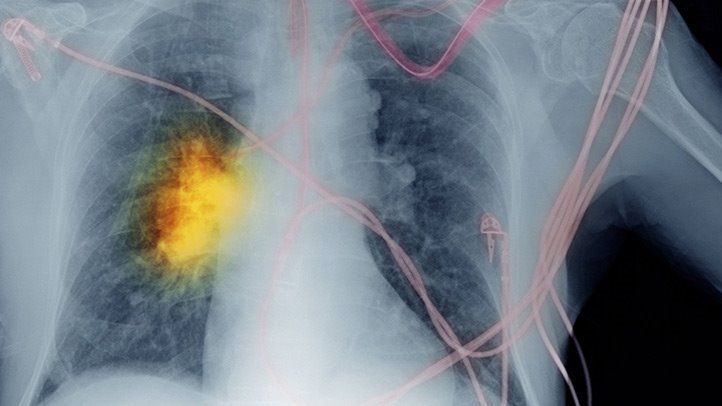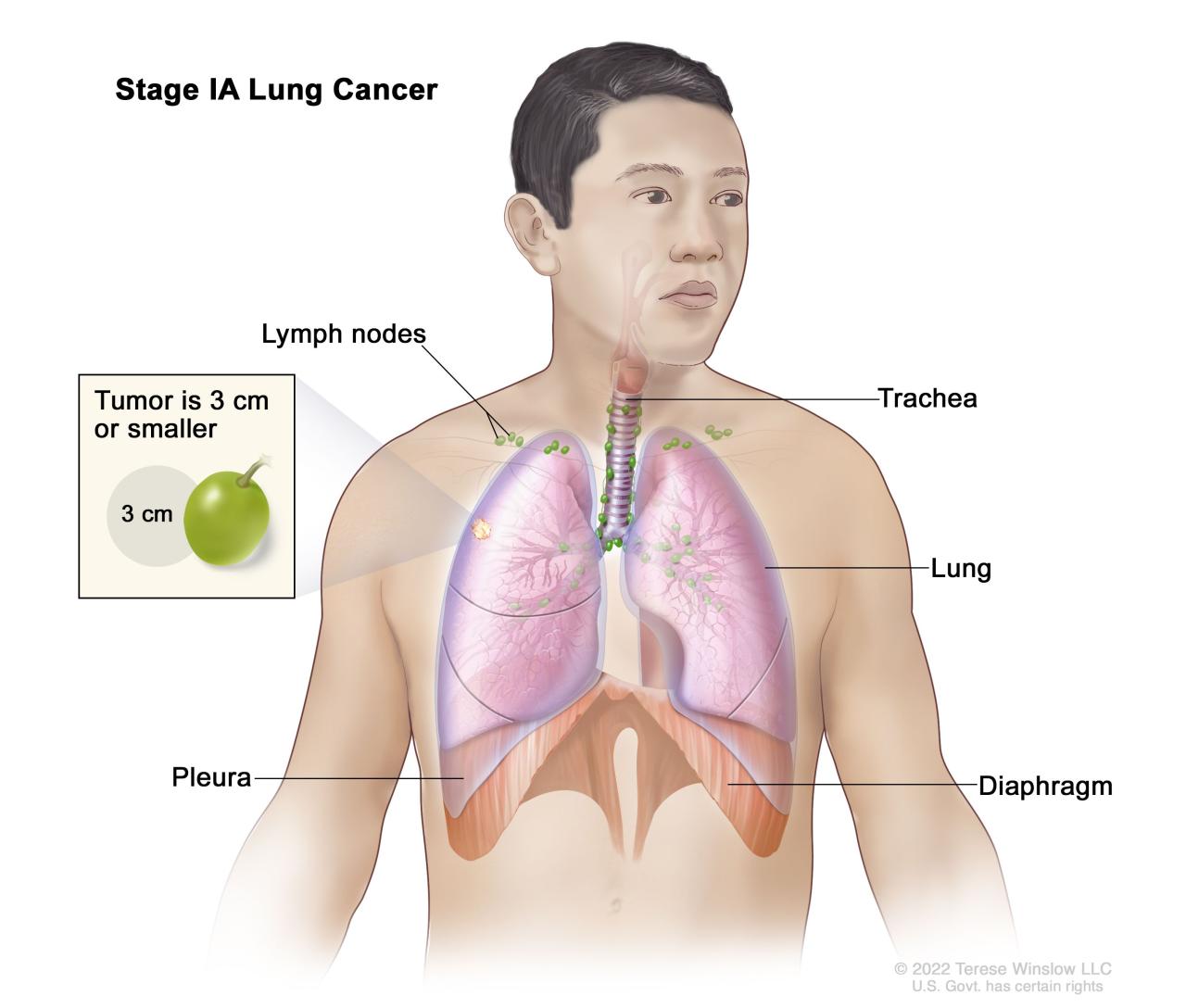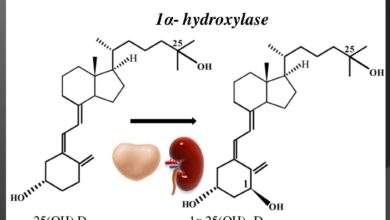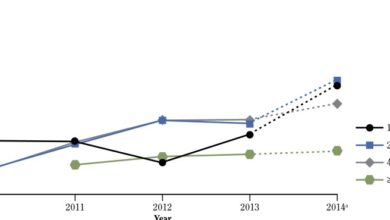
Smoking and non small cell lung cancer – Smoking and non-small cell lung cancer (NSCLC) are deeply intertwined. This exploration delves into the complex relationship, examining the mechanisms by which smoking fuels NSCLC development. We’ll analyze different NSCLC types, historical trends in incidence, and risk factors beyond tobacco use. The comparison between smokers and non-smokers, in terms of NSCLC prevalence, will be a key part of the discussion.
Beyond the direct link between smoking and NSCLC, we’ll explore other influential factors like genetics and environmental exposures. The synergistic effects of these factors on cancer risk will be highlighted. We’ll also discuss the importance of personalized treatment approaches and the role of lifestyle modifications in the treatment process. The varying stages of NSCLC, progression patterns, and diagnostic methods will be examined in detail.
Introduction to Smoking and Non-Small Cell Lung Cancer (NSCLC)

Smoking is a profoundly significant risk factor for Non-Small Cell Lung Cancer (NSCLC). The association is well-established through decades of epidemiological research and meticulously documented clinical observations. This link underscores the crucial role of tobacco smoke in initiating and promoting lung cancer development. Understanding the mechanisms and types of NSCLC associated with smoking, along with historical trends and prevalence data, is essential for prevention and treatment strategies.Smoking’s detrimental effects on lung health manifest through a complex interplay of chemical and biological processes.
Exposure to the numerous toxins in cigarette smoke damages the delicate lining of the lungs, leading to chronic inflammation and cellular mutations. Over time, these cumulative effects increase the likelihood of malignant transformation, ultimately resulting in NSCLC.
Mechanisms of Smoking-Induced NSCLC Development
The intricate process of NSCLC development due to smoking involves several key mechanisms. Cigarette smoke contains thousands of harmful chemicals, many of which are directly carcinogenic. These carcinogens induce DNA damage, leading to mutations in lung cells. The immune system’s ability to repair this damage is often compromised, allowing the mutated cells to proliferate and evade immune surveillance.
Chronic inflammation, a hallmark of smoking-related lung disease, further creates a conducive environment for cancer growth. This ongoing inflammation provides signals that stimulate cell growth and division, and can lead to further mutations.
Types of NSCLC and Smoking
NSCLC encompasses several distinct histological subtypes. Adenocarcinoma is the most common type, frequently associated with smoking. Squamous cell carcinoma, another prevalent subtype, also has a strong correlation with smoking history. Large cell carcinoma, less common, is also linked to smoking. While all these types are influenced by smoking, the specific mechanisms and patterns of development may differ.
Historical Trends in Smoking-Related Lung Cancer Incidence, Smoking and non small cell lung cancer
Historical data reveals a clear correlation between increased smoking prevalence and the rising incidence of lung cancer. Early 20th-century studies showed a gradual increase in lung cancer cases as smoking rates rose. The subsequent decades saw a further escalation, reaching a peak in the mid-20th century. More recent data indicates a decline in lung cancer incidence, potentially linked to public health campaigns and decreased smoking rates.
This demonstrates a direct causal relationship between smoking and lung cancer, and the impact of public health initiatives in mitigating the problem.
Prevalence of NSCLC in Smokers vs. Non-Smokers
This table highlights the significant difference in NSCLC prevalence between smokers and non-smokers.
| Characteristic | Smokers | Non-Smokers | Comparison |
|---|---|---|---|
| Prevalence of NSCLC | Significantly higher | Significantly lower | Smokers have a considerably higher risk of developing NSCLC compared to non-smokers. |
Data on exact prevalence rates varies by region and specific studies, but the overall trend is consistent: smoking dramatically increases the risk of developing NSCLC. Consider a hypothetical example: a study in a specific city might show that smokers have a 20-fold higher risk of NSCLC than non-smokers. This substantial difference underscores the critical need for smoking cessation programs and public health initiatives.
Risk Factors Beyond Smoking
While smoking is the overwhelmingly largest risk factor for Non-Small Cell Lung Cancer (NSCLC), other factors significantly contribute to the development of the disease. Understanding these additional risk factors is crucial for comprehensive prevention strategies and tailored treatment plans. These factors, while individually less impactful than smoking, can act in concert with smoking to dramatically increase risk.The complexity of NSCLC development arises from the interplay of multiple factors.
Simply put, it’s not just one thing, but a combination of elements that increase a person’s likelihood of getting this disease. Understanding the relative importance of each factor, and their potential interactions, is vital to improving prevention and care.
Genetic Predisposition
Genetic factors play a significant role in susceptibility to NSCLC. Certain gene mutations can increase a person’s risk. Inherited genetic variations can influence how the body processes carcinogens and repairs DNA damage. Individuals with a family history of lung cancer, especially NSCLC, are often at a higher risk. Research into specific genetic markers continues to advance, allowing for earlier identification and targeted prevention strategies for those at high genetic risk.
Environmental Exposures
Environmental factors are another critical aspect to consider. Exposure to radon, asbestos, and certain air pollutants significantly increases the risk of developing NSCLC. Radon, a naturally occurring radioactive gas, can accumulate in homes and workplaces, causing long-term exposure. Asbestos, a mineral fiber, has been linked to lung cancer, especially when exposure occurs over time. Air pollutants, both indoors and outdoors, contribute to overall lung damage, increasing the likelihood of developing lung cancer.
The impact of these environmental exposures varies based on duration and intensity of exposure.
Other Risk Factors
Other factors, though less prominent than smoking and genetics, can contribute to NSCLC. These include a history of chronic lung disease, such as chronic obstructive pulmonary disease (COPD), and exposure to certain chemicals in the workplace. People with pre-existing lung conditions, like severe asthma or cystic fibrosis, might be more susceptible to lung cancer.
Synergistic Effects
The synergistic effect of smoking combined with other risk factors is a significant concern. For instance, a person with a genetic predisposition to lung cancer and a history of asbestos exposure who also smokes has a substantially elevated risk compared to someone with only one or two of these risk factors. This multiplicative effect underscores the importance of considering multiple risk factors simultaneously.
These factors act in concert to increase the probability of developing NSCLC.
Smoking is a major risk factor for non-small cell lung cancer, but predicting who will develop the disease is still a challenge. Researchers are looking at various factors, including genetic predispositions, and environmental exposures, which mirrors the complex task of predicting who will get progressive MS. Ultimately, understanding the intricate interplay of factors behind these diseases, including smoking, is key to better prevention and treatment strategies.
Importance of Considering Multiple Risk Factors
A comprehensive assessment of risk factors is essential in the diagnosis and treatment of NSCLC. This involves a thorough evaluation of smoking history, genetic predispositions, environmental exposures, and other relevant factors. Identifying these factors helps in tailoring prevention strategies, determining prognosis, and selecting the most appropriate treatment approach.
Combined Impact of Smoking and Genetics on NSCLC Risk
| Factor | Smoking | Genetics | Combined Effect |
|---|---|---|---|
| Risk | High | Moderate to High | Extremely High |
Note: This table represents a general trend. The exact risk level varies significantly depending on the specific genetic mutations, the extent of smoking, and the duration and intensity of environmental exposures. For example, a person with a strong family history of lung cancer and heavy smoking is at an extremely high risk. Similarly, someone with a weaker genetic predisposition and minimal exposure to environmental factors may have a lower risk.
Stages and Progression of NSCLC: Smoking And Non Small Cell Lung Cancer
Non-small cell lung cancer (NSCLC) is a complex disease, and its progression varies significantly from person to person. Understanding the stages of NSCLC and how it typically progresses in smokers is crucial for early detection and effective treatment. Early diagnosis and intervention can dramatically improve outcomes.The progression of NSCLC is influenced by a multitude of factors, including the type of NSCLC, the individual’s overall health, and the aggressiveness of the tumor.
While smoking is a major risk factor, other factors like genetics and environmental exposures play a role.
Stages of NSCLC Development
The staging of NSCLC is a crucial aspect of determining the appropriate treatment plan and predicting the prognosis. Staging systems categorize the cancer based on its size, location, and spread. The most common staging system is the TNM system, which considers the tumor size (T), the involvement of lymph nodes (N), and the presence of distant metastasis (M).
Each stage represents a different level of severity, with later stages indicating more advanced disease.
Typical Progression of NSCLC in Smokers
In smokers, NSCLC often progresses more rapidly than in non-smokers due to the cumulative damage caused by years of smoking. The chronic inflammation and cellular damage associated with smoking can create a more favorable environment for cancer development and growth. The initial stages may be asymptomatic, making early detection challenging. As the disease advances, symptoms become more pronounced, and the cancer may spread to other parts of the body.
It is important to remember that individual experiences can differ, and the progression rate can vary significantly.
Diagnostic Methods for NSCLC
Several diagnostic methods are used to detect and diagnose NSCLC, each with its own strengths and limitations. These methods include imaging techniques such as X-rays, CT scans, and PET scans, which can help identify tumors and assess their extent. Biopsy procedures, including bronchoscopy and lung biopsies, are used to obtain tissue samples for microscopic examination and confirmation of the diagnosis.
Blood tests can also play a role in monitoring the cancer’s progression and evaluating the overall health status.
Effectiveness of Early Detection Methods
Early detection is paramount in improving treatment outcomes for NSCLC. While screening programs exist, the effectiveness of these programs can vary. Smokers often have a higher risk of developing NSCLC, which makes screening more crucial for them. However, the effectiveness of early detection methods is not uniformly high across all populations. For example, smokers may have more lung abnormalities that could potentially be detected earlier than non-smokers, leading to better outcomes with early intervention.
The effectiveness of early detection is further influenced by access to healthcare and the individual’s willingness to undergo screening.
Symptoms at Each Stage of NSCLC
| Stage | Symptoms | Progression |
|---|---|---|
| Early | Often asymptomatic, or may include persistent cough, shortness of breath, or chest pain. Some individuals might experience fatigue or unexplained weight loss. | The tumor is localized, and there is minimal spread. Treatment options are more effective at this stage. |
| Intermediate | Symptoms may include persistent cough, shortness of breath, chest pain, hoarseness, wheezing, and recurrent infections. There may also be symptoms related to the location of the tumor, such as difficulty swallowing or arm weakness. | The cancer has begun to spread to nearby lymph nodes. Treatment options are still available, but the prognosis is less favorable than in early stages. |
| Late | Symptoms are more severe and may include significant shortness of breath, chest pain, weight loss, fatigue, and recurring infections. Symptoms may also include complications from the spread of the cancer, such as bone pain or neurological issues. | The cancer has spread extensively to distant organs. Treatment options are often palliative, focused on managing symptoms and prolonging survival. |
Treatment Options for NSCLC in Smokers
Non-small cell lung cancer (NSCLC) is a significant health concern, especially for smokers. Understanding the available treatment options and their effectiveness is crucial for both patients and healthcare providers. This section will delve into the various approaches used to combat NSCLC in smokers, from surgery and chemotherapy to targeted therapies and the importance of personalized strategies.
Common Treatment Approaches
The treatment strategy for NSCLC in smokers depends heavily on the stage of the cancer and the patient’s overall health. Common treatment options include surgery, chemotherapy, radiation therapy, and targeted therapies. Each approach has its own strengths and limitations, and their effectiveness can vary significantly depending on individual factors.
Surgery
Surgical resection is often a primary treatment option for early-stage NSCLC. It involves the removal of the tumor and surrounding affected tissue. For smokers with localized tumors, surgery can offer a chance of cure, especially when combined with other therapies. The success of surgery depends on the extent of the cancer and the patient’s overall health, with factors like age, other medical conditions, and the location of the tumor playing significant roles in the decision-making process.
Chemotherapy
Chemotherapy uses drugs to kill cancer cells. It’s often used in conjunction with other treatments, such as surgery or radiation, to reduce the risk of recurrence. In smokers with advanced NSCLC, chemotherapy can help shrink tumors, alleviate symptoms, and improve quality of life. The effectiveness of chemotherapy can vary based on the specific drugs used, the patient’s response, and the stage of the disease.
Smoking is a major risk factor for non-small cell lung cancer, a serious and often aggressive disease. It’s important to prioritize your health, and while tackling such a significant issue can feel daunting, remember that taking small steps towards a healthier lifestyle can make a huge difference. Learning to be your best self, which includes understanding the risks associated with smoking, is crucial.
Check out some fun ways to improve your outlook and well-being by reading sunday funnies being your best self – maybe a good laugh will help motivate you to quit! Ultimately, understanding these risks and actively working towards a healthier you is key to fighting diseases like non-small cell lung cancer.
Radiation Therapy
Radiation therapy uses high-energy rays to target and destroy cancer cells. It can be used as a standalone treatment or in combination with surgery or chemotherapy. For smokers with NSCLC, radiation therapy can help shrink tumors, reduce pain, and alleviate other symptoms. Its effectiveness is often assessed in conjunction with other treatment options to achieve optimal outcomes.
Targeted Therapies
Targeted therapies are drugs that specifically target cancer cells’ growth pathways. These therapies are often used in advanced NSCLC cases where surgery is not a viable option or when the cancer has spread. They can effectively slow the growth of cancer cells and improve survival rates. The success of targeted therapies depends on the specific genetic alterations present in the cancer cells.
Lifestyle Modifications
Lifestyle modifications, although not a direct treatment for NSCLC, can play a significant role in improving the patient’s overall health and response to treatment. Quitting smoking, maintaining a healthy diet, and engaging in regular exercise are vital for improving overall health and well-being. These lifestyle choices can positively impact the patient’s response to treatment, potentially enhancing the effectiveness of chemotherapy, radiation therapy, and surgery.
Personalized Treatment Strategies
Personalized treatment strategies are crucial in effectively managing NSCLC in smokers. This approach considers the individual patient’s cancer characteristics, including the tumor’s genetic makeup and stage, to tailor treatment plans to maximize effectiveness and minimize side effects. The use of genomic testing to identify specific genetic mutations in the cancer cells is becoming increasingly important in designing effective personalized treatment strategies.
Effectiveness of Different Treatments
| Treatment | Effectiveness (Smokers) | Effectiveness (Non-Smokers) |
|---|---|---|
| Surgery | Generally effective for early-stage, localized tumors, but success depends on individual factors | Generally effective for early-stage, localized tumors, but success depends on individual factors |
| Chemotherapy | Can shrink tumors and improve quality of life in advanced stages, but effectiveness varies | Can shrink tumors and improve quality of life in advanced stages, but effectiveness varies |
| Radiation Therapy | Can shrink tumors and reduce symptoms, often used in combination with other treatments | Can shrink tumors and reduce symptoms, often used in combination with other treatments |
| Targeted Therapies | Show promise for specific genetic mutations, but effectiveness varies based on mutation type | Show promise for specific genetic mutations, but effectiveness varies based on mutation type |
Prevention and Early Detection Strategies
Non-small cell lung cancer (NSCLC) is a significant health concern, but proactive steps can significantly reduce its impact. Prevention and early detection play crucial roles in improving outcomes and saving lives. Understanding the strategies available can empower individuals to take control of their health and potentially prevent or mitigate the risks associated with NSCLC.
The Importance of Smoking Cessation
Smoking is the leading cause of NSCLC. Quitting smoking is the single most important preventative measure an individual can take. The benefits of smoking cessation are substantial and extend across multiple health dimensions, including a reduced risk of developing NSCLC. Studies have consistently shown that the risk of NSCLC decreases significantly within a few years of quitting.
Furthermore, the risk continues to decline over time, indicating that long-term cessation yields further benefits. A smoker who quits significantly reduces their chances of developing NSCLC compared to someone who continues to smoke.
The Role of Screening Programs
Early detection significantly improves treatment outcomes for NSCLC. Screening programs, particularly low-dose computed tomography (LDCT) scans, are designed to identify NSCLC in its early stages, often before symptoms appear. These programs are especially beneficial for high-risk individuals, such as smokers or those with a family history of lung cancer. LDCT screening can detect small lung nodules, which may be cancerous, allowing for prompt intervention.
Smoking is a major risk factor for non-small cell lung cancer, a devastating disease. While focusing on health is important, sometimes we need a little beauty boost too! Learning how to grow out eyebrows, for example, can be a fun and rewarding process. how to grow out eyebrows can actually be a good way to feel better about yourself while you tackle the important issue of smoking cessation and its impact on lung health.
It’s a reminder that taking care of ourselves encompasses more than just one area. Ultimately, making healthy choices is key to preventing diseases like non-small cell lung cancer.
By catching the cancer early, treatment can be more effective and potentially less aggressive.
Benefits of Early Diagnosis and Treatment
Early diagnosis and treatment for NSCLC are critical factors in improving survival rates. When NSCLC is detected early, before it has spread, treatment options are often less invasive and more effective. Surgical removal of the tumor, chemotherapy, and radiation therapy are examples of treatment options that are more likely to be successful in the early stages of the disease.
The chance of a complete cure is higher, and the need for aggressive or life-altering treatments can be minimized.
Potential of Preventative Measures to Reduce Smoking-Related NSCLC
Public health initiatives that promote smoking cessation and discourage smoking initiation are vital in reducing the burden of smoking-related NSCLC. These strategies, combined with early detection programs, can have a profound impact on reducing the number of NSCLC cases and improving overall public health. Educational campaigns, support groups, and accessible cessation therapies can help individuals quit smoking. A combination of these strategies can contribute significantly to a reduction in smoking-related NSCLC.
Visual Representation of Smoking Cessation Impact
Imagine a graph with time on the x-axis and lung health on the y-axis. The line representing a smoker’s lung health would initially be relatively high, but it would steadily decline over time. After the smoker quits, the line would start to level off and gradually improve, although it would never fully recover to the same level as a non-smoker’s lung health.
The rate of improvement depends on the length of time the person has smoked and how long they have remained smoke-free. This illustrates that while the damage done by smoking cannot be fully undone, quitting smoking has significant and positive long-term effects on lung health and reduces the risk of NSCLC.
Long-Term Impact of Smoking on NSCLC Patients

The long-term effects of smoking on Non-Small Cell Lung Cancer (NSCLC) patients extend far beyond the initial diagnosis. Smoking significantly impacts the physical and psychological well-being of these individuals, often exacerbating the challenges associated with the disease itself. This section delves into the lasting consequences of smoking, the benefits of cessation, and available support systems for patients.Smoking, even after diagnosis, continues to pose a threat to the patient’s health and well-being.
The body’s compromised ability to heal, coupled with the continued effects of nicotine, can lead to a variety of physical and psychological struggles. The severity of these impacts can vary depending on the individual and the stage of the disease.
Physical Effects of Continued Smoking
Continued smoking during and after NSCLC diagnosis can negatively affect treatment outcomes and overall health. Nicotine interferes with the healing process, impacting the effectiveness of chemotherapy, radiation therapy, and surgery. This can lead to complications during and after treatment, including slower recovery times and an increased risk of infection. Further, the ongoing inflammation caused by smoking can exacerbate existing lung damage and lead to additional respiratory problems.
Psychological Effects of Continued Smoking
The psychological impact of smoking on NSCLC patients is often overlooked but equally significant. The constant battle with cravings and withdrawal symptoms can significantly affect their mental well-being. Feelings of guilt, regret, and self-blame can contribute to anxiety and depression. Smoking can also impede a patient’s ability to cope with the emotional and psychological challenges of the disease.
Impact of Smoking Cessation on Treatment Outcomes
Smoking cessation, even after diagnosis, can demonstrably improve treatment outcomes. Studies have shown that quitting smoking can enhance the effectiveness of cancer therapies and improve overall survival rates. Stopping the intake of nicotine allows the body to heal more effectively and reduces the risk of treatment complications. This is particularly important in improving the patient’s ability to endure the rigorous treatments associated with NSCLC.
Support Systems for NSCLC Patients
Comprehensive support systems are crucial for NSCLC patients, particularly those who are smokers. These systems should address both the physical and psychological needs of the patients. Support groups, counseling services, and educational programs can offer a sense of community and guidance. Furthermore, access to professionals specializing in oncology, pulmonary rehabilitation, and mental health can provide personalized support and tailored strategies for coping with the challenges of the disease.
Role of Rehabilitation in Managing Long-Term Effects
Pulmonary rehabilitation plays a critical role in managing the long-term effects of NSCLC, especially for smokers. Rehabilitation programs often include breathing exercises, physical therapy, and education on managing symptoms. These programs are designed to improve lung function, enhance physical endurance, and alleviate symptoms of chronic lung conditions. Rehabilitation can significantly improve the quality of life for NSCLC patients, enabling them to better cope with the physical and emotional challenges of the disease.
Comparison of Quality of Life for Smokers and Non-Smokers with NSCLC
| Factor | Smokers | Non-Smokers |
|---|---|---|
| Quality of Life (QoL) | Generally lower QoL due to continued respiratory issues, potential treatment complications, and psychological distress from nicotine cravings and withdrawal. | Potentially higher QoL due to a reduced likelihood of treatment complications and a lower risk of exacerbating pre-existing respiratory conditions. |
Outcome Summary
In conclusion, smoking significantly impacts the development, progression, and treatment of non-small cell lung cancer. Understanding the intricate interplay of risk factors, diagnostic methods, and treatment options is crucial for improving outcomes. Prevention strategies, including smoking cessation, and early detection programs are vital for mitigating the devastating impact of this disease. The long-term implications for patients, both physical and psychological, will also be addressed.
Ultimately, this exploration emphasizes the importance of comprehensive strategies to combat this prevalent form of cancer.



